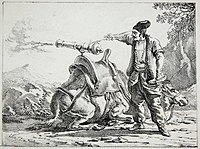
Back زنبورك Arabic Zamburak Spanish زنبورک (جنگافزار) Persian Zamburak French ज़ंबूरक Hindi Zamburak Italian ザンブーラキ Japanese Zamburakas Lithuanian زنبورک MZN Zamburak Dutch
| Zamburak | |
|---|---|
 17th century Persian artilleryman operating a Zamburak | |
| Active | 17th century – early 20th century[1] |
| Country | Mughal Empire Afsharid Iran Durrani Empire Dzungar Khanate |
| Branch | Cavalry |
| Equipment | arquebus musket artillery |
Zamburak (Persian: زنبورک), literally meaning wasp, was a specialized form of self-propelled artillery from the early modern period, featuring small swivel guns mounted on and fired from camels. Its operator was known as a zamburakchi. It was used by the gunpowder empires, especially the Iranian empires of the Safavid dynasty, Timurid Empire, and Afsharid dynasty, due to the ruggedness of the Iranian Plateau, which made typical transportation of heavy cannons difficult.
The zamburak became a popular mode of warfare in the 18th century in Indian subcontinent. The Pashtuns used it in the Battle of Gulnabad, routing a numerically superior imperial Safavid army. It was also used successfully in Nader's Campaigns, when the shah and military genius Nader Shah utilized a zamburak corps in conjunction with a regular corps of conventional cannon to devastating effect in numerous battles such as at the Battle of Damghan (1729), the Battle of Yeghevārd, and the Battle of Karnal. A large number of zamburaks were also successfully employed by Ahmed Shah Durrani during his raid in north Indian plain in defeating the Maratha forces near Panipat.
- ^ A camel with rider and gun. Jalpur the zamburak first ... - ifunny. (n.d.). https://ifunny.co/picture/a-camel-with-rider-and-gun-jalpur-the-zamburak-first-uVfOclLYA
© MMXXIII Rich X Search. We shall prevail. All rights reserved. Rich X Search